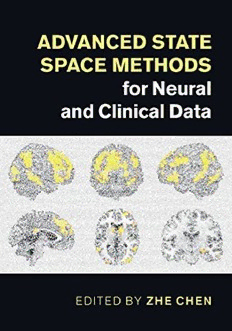Table Of ContentAdvancedStateSpaceMethodsforNeuralandClinicalData
This authoritative work provides an in-depth treatment of state space methods, with a
rangeofapplicationsinneuralandclinicaldata.
Advanced and state-of-the-art research topics are detailed, including topics in state
space analyses, maximum likelihood methods, variational Bayes, sequential Monte
Carlo,MarkovchainMonteCarlo,nonparametricBayesiananddeeplearningmethods.
Details are provided on practical applications in neural and clinical data, whether
this is characterizing time series data from neural spike trains recorded from the
rat hippocampus, the primate motor cortex, or the human EEG, MEG or fMRI, or
physiologicalmeasurementsofheartbeatsorbloodpressures.
Withreal-worldcasestudiesofneuroscienceexperimentsandclinicaldatasets,and
written by expert authors from across the field, this is an ideal resource for anyone
workinginneuroscienceandphysiologicaldataanalysis.
ZheChenisAssistantProfessorattheNewYorkUniversitySchoolofMedicine,having
previouslyworkedattheRIKENBrainScienceInstitute,HarvardMedicalSchool,and
Massachusetts Institute of Technology. He is a Senior Member of the IEEE and an
editorial board member of Neural Networks (Elsevier). Professor Chen has received a
numberofawardsincludingtheEarlyCareerAwardfromtheMathematicalBiosciences
Institute,andhashadhisworkfundedbytheUSNationalScienceFoundation.
Advanced State Space Methods
for Neural and Clinical Data
Editedby
ZHE CHEN
NewYorkUniversitySchoolofMedicine
UniversityPrintingHouse,CambridgeCB28BS,UnitedKingdom
CambridgeUniversityPressispartoftheUniversityofCambridge.
ItfurtherstheUniversity’smissionbydisseminatingknowledgeinthepursuitof
education,learningandresearchatthehighestinternationallevelsofexcellence.
www.cambridge.org
Informationonthistitle:www.cambridge.org/9781107079199
©CambridgeUniversityPress2015
Thispublicationisincopyright.Subjecttostatutoryexception
andtotheprovisionsofrelevantcollectivelicensingagreements,
noreproductionofanypartmaytakeplacewithoutthewritten
permissionofCambridgeUniversityPress.
Firstpublished2015
PrintedintheUnitedKingdombyTJInternationalLtd,PadstowCornwall
AcataloguerecordforthispublicationisavailablefromtheBritishLibrary
LibraryofCongressCataloguinginPublicationdata
Advancedstatespacemethodsforneuralandclinicaldata/editedbyZheChen.
p.;cm.
Includesbibliographicalreferences.
ISBN978-1-107-07919-9(Hardback)
I. Chen,Zhe,1976–,editor.
[DNLM:1. Models,Statistical. 2. Neurology. 3. StochasticProcesses.WL100]
RC346
(cid:2)
616.80011–dc23 2015003085
ISBN978-1-107-07919-9Hardback
CambridgeUniversityPresshasnoresponsibilityforthepersistenceoraccuracy
ofURLsforexternalorthird-partyinternetwebsitesreferredtointhispublication,
anddoesnotguaranteethatanycontentonsuchwebsitesis,orwillremain,
accurateorappropriate.
Contents
Listofcontributors pagexv
Preface xix
1 Introduction 1
Z.Chen
1.1 Abriefoverviewofstatespaceanalysis 1
1.1.1 Mathematicalbackground 1
1.1.2 Unobservedvariablesandstochasticdynamicalsystems 1
1.1.2.1 Stateequation 2
1.1.2.2 Observationequation 2
1.1.3 Observability,controllabilityandstability 3
1.1.4 Bayes’rule 3
1.1.5 RecursiveBayesianestimation 4
1.1.6 Twoillustratedexamples 5
1.2 Inferenceandlearning 7
1.3 Applicationsinneuroscienceandmedicine 9
References 10
2 InferenceandlearninginlatentMarkovmodels 14
D.BarberandS.Chiappa
2.1 Probabilistictimeseriesmodels 14
2.1.1 Agraphicaldepiction 14
2.2 FullyobservedMarkovmodels 15
2.2.1 Scalarhigher-orderandequivalentvectormodel 16
2.3 LatentMarkovmodels 17
2.3.1 InferenceinlatentMarkovmodels 18
2.3.1.1 Filtering 18
2.3.1.2 Parallelsmoothing 19
2.3.1.3 Correctionsmoothing 19
2.3.1.4 Prediction 20
2.3.2 DiscretestatelatentMarkovmodels 20
2.3.2.1 Explicit-durationmodels 21
2.3.3 ContinuousstatelatentMarkovmodels 22
v
vi Contents
2.3.4 Inferenceinlineardynamicalsystems 23
2.4 TheswitchingLDS 23
2.4.1 Exactinferenceiscomputationallyintractable 24
2.4.2 Gaussiansumfiltering 24
2.4.3 Gaussiansumsmoothing 25
2.4.4 Clinicalexample 25
2.5 Resetmodels 29
2.6 DeterministiclatentMarkovmodels 30
2.6.1 Time-varyingvarianceARmodels 31
2.6.2 Parameterestimation 32
2.6.3 Neuralmodels 33
2.6.3.1 Hopfieldmembranepotential 34
2.6.3.2 AnaugmentedHopfieldnetwork 35
2.6.3.3 Dynamicsynapses 35
2.6.3.4 Leakyintegrate-and-firemodels 37
2.7 Approximateinference 38
2.7.1 MonteCarlomethods 38
2.7.2 Variationalinference 39
2.7.3 Assumeddensityfilteringandsmoothing 39
2.7.4 Importancesampling 40
2.7.5 Sequentialimportancesampling 41
2.7.6 Particlefilteringasassumeddensityfiltering 42
2.8 Parameterestimation 43
2.8.1 EstimationindiscretestateMarkovmodels 44
2.8.2 Autoregressive(AR)models 45
2.8.3 VariationalBayes 46
2.9 Summary 47
Acknowledgements 48
References 48
PartI Statespacemethodsforneuraldata 51
3 StatespacemethodsforMEGsourcereconstruction 53
M.Fukushima,O.YamashitaandM.Sato
3.1 Introductionandproblemformulation 53
3.2 Overviewofsourcereconstructionmethods 54
3.2.1 Normregularizationmethods 55
3.2.2 Bayesianmethods 56
3.2.3 Statespacemethods 57
3.2.4 Challenges 57
3.2.5 Solutions 58
3.2.5.1 Reducingcomputationtime 58
3.2.5.2 Reducingthenumberofparameters 58
Contents vii
3.3 Detailsofnewmethods 59
3.3.1 Diagonalstatespacemethod(dSSM) 59
3.3.1.1 Probabilisticmodel 59
3.3.1.2 Estimationalgorithm 61
3.3.2 Fullstatespacemethod(fSSM) 64
3.3.2.1 Probabilisticmodel 64
3.3.2.2 Estimationalgorithm 65
3.3.2.3 Computationofstructuralconnectivity 66
3.4 Results:methodevaluation 66
3.4.1 Diagonalstatespacemethod(dSSM) 66
3.4.1.1 Simulationanalysis 66
3.4.1.2 Realdataanalysis 68
3.4.2 Fullstatespacemethod(fSSM) 69
3.4.2.1 Simulationanalysis 69
3.4.2.2 Realdataanalysis 71
3.5 Discussion 71
3.6 Futuredirections 74
3.7 Conclusion 75
Acknowledgments 75
References 76
4 AutoregressivemodelingoffMRItimeseries:statespaceapproaches
andthegenerallinearmodel 79
A.Galka,M.Siniatchkin,U.Stephani,K.Groening,S.Wolff,J.Bosch-BayardandT.Ozaki
4.1 Introduction 79
4.2 StructureoffMRItimeseries 81
4.3 Innovationapproachandmaximum-likelihoodestimation 82
4.4 Maximum-likelihoodestimationinpractice 84
4.5 GenLMasadeterministicstatespacemodel 85
4.5.1 fMRImodelingbyGenLM 85
4.5.2 Coloredobservationnoise 86
4.5.3 AstatespacemodelfortheHRF 87
4.5.4 Fromcontinuoustimetodiscretizedtime 88
4.5.5 Introducingcoloredobservationnoise 89
4.5.6 ThestatespaceGenLMmodel 90
4.6 GenerallinearstatespacemodelsforfMRI 92
4.6.1 MultivariateAR/ARXmodels 92
4.6.2 Nearest-neighborARmodeling 93
4.6.3 Spatialwhitening 94
4.6.4 TheNNARXmodelwithspatialwhitening 96
4.6.5 StatespacegeneralizationoftheNNARXmodel 96
4.6.6 Thecaseofnon-Gaussiandata 97
4.6.7 ThestatespaceNNARXmodelwithspatialwhitening 98
viii Contents
4.7 Estimationofmodelparameters 99
4.7.1 NNARXmodel 99
4.7.2 GenLM-SSmodel 100
4.7.3 NNARX-SSmodel 101
4.8 ClinicalfMRItimeseriesexample 102
4.8.1 Experimentalsetupandpreprocessing 102
4.8.2 Numericalresultsofmodelfitting 104
4.8.3 ModelcomparisonbyAICandBIC 104
4.8.4 Furtherresults 106
4.9 Discussion 107
Acknowledgments 110
References 110
5 Statespacemodelsandtheirspectraldecompositionindynamiccausal
modeling 114
R.Moran
5.1 Introduction 114
5.2 Overviewoftheliterature 116
5.3 Methodology 119
5.3.1 Aneuralmassmodelinthetimedomain 119
5.3.2 Statespaceformulation 122
5.3.2.1 Inhibitorycellsinsupragranularlayers 122
5.3.2.2 Excitatoryspinycellsingranularlayers 122
5.3.2.3 Excitatorypyramidalcellsininfragranularlayers 123
5.3.3 Alinearapproximationtotheneuralmassmodel 123
5.3.4 Themodulationtransferfunctionusingthelinearapproximation 124
5.3.4.1 Poles,zerosandLyapunovexponents 125
5.3.5 Spectralgenerationinnonlinearmodels 126
5.4 Applications 127
5.5 Discussion 130
References 133
6 Estimatingstateandparametersinstatespacemodelsofspiketrains 137
J.H.Macke,L.BuesingandM.Sahani
6.1 Introduction 137
6.1.1 Statespacemodelsforneuralpopulationspiketrains 137
6.1.2 PLDSmodelsincontext 138
6.2 Statespacemodelswithlineardynamicsandcount-processobservations 139
6.3 Reconstructingthestatefromneuralspiketrains 141
6.3.1 InferringthestateusingtheLaplaceapproximation 142
6.3.2 InferringthestatedistributionusingGaussianvariationalinference 144
6.4 Estimatingmodelparameters 147
Contents ix
6.4.1 Expectation maximization (EM): estimating parameters via
iterativelyoptimizingacostfunction 147
6.4.2 Learningparametersofthemodelthroughspectrallearning 149
6.4.2.1 Subspace-IDforGLDSmodels 150
6.4.2.2 Subspace-ID for the PLDS model by moment
conversion 151
6.5 Results 152
6.6 Discussion 155
6.7 Summary 155
Acknowledgements 156
References 156
7 Bayesianinferenceforlatentsteppingandrampingmodelsofspiketraindata 160
K.W.Latimer,A.C.HukandJ.W.Pillow
7.1 Background:dynamicsofneuraldecisionmaking 160
7.2 Overview 161
7.3 Point-processmodelsofdecisionmaking 163
7.3.1 MarkovchainMonteCarlo(MCMC)inference 164
7.3.2 Diffusion-to-boundmodel 166
7.3.2.1 Inferencefordiffusion-to-boundmodel 168
7.3.2.2 Step1:Samplingthelatenttrajectories 168
7.3.2.3 Step2:Samplingtheparameters 171
7.3.3 Switchingmodel 173
7.3.3.1 Step1:Samplingthelatentstates 175
7.3.3.2 Step2:Samplingtheparameters 176
7.3.4 Modelcomparison 177
7.4 Results 178
7.4.1 Comparisontomoment-basedmethods 180
7.5 Discussion 182
7.6 Conclusion 183
Acknowledgments 183
References 184
8 Probabilisticapproachestouncoverrathippocampalpopulationcodes 186
Z.Chen,F.KloostermanandM.A.Wilson
8.1 Background 186
8.2 Decodeunsortedneuronalspikesfromtherathippocampus 186
8.2.1 Overview 186
8.2.2 Bayesiandecoding 187
8.2.3 LikelihoodforaspatiotemporalPoissonprocess 188
8.2.4 Kerneldensityestimation(KDE) 190
8.2.5 RecursiveBayesianestimationviastatespaceanalysis 192

